Andy Paul's Blog, page 9
November 27, 2019
Why Process is Paramount: 6 Building Blocks for an Effective Sales Process
1.
How you execute your daily sales process is the
most accurate predictor of sales success.
2.
Effective processes are a means to enhance selling
skills.
3.
Your sales can only be as fast as your slowest
link. Identify and fix the bottlenecks in your sales processes.
4.
Sellers cannot control buyers. They can only
control their own actions
5.
Take 6 simple steps to control your selling and
compress buying cycles.
Why
Process is Paramount: 6 Building Blocks for an Effective Sales Process
Why Process is Paramount in Selling
This is one of the classic debates about sales and selling. It is very similar to the ‘nature vs. nurture’ debates that young adults without kids and too much time on their hands indulge in. (Anyone with kids quickly learns the answer to this…) The answer is that both process and skill are required to succeed in sales. However, process provides the platform for skills to flourish.

What Would Michael Do?
Take the case of an elite athlete
like Michael Phelps, the all-time Olympic champion swimmer. Michael Phelps
trains like a demon, spending hours face down in a pool every day, to showcase
his skills on the world’s biggest stage, the Olympics. He won an unprecedented
8 gold medals in swimming at the Beijing Games in 2008. There is no doubting
his obvious skills. Having conquered the world once, the question was would he
return to the London games in 2012 and try again?
In preparation for the Beijing Olympics, Michael followed the training regimen put together by his coach, Bob Bowman. It was a process that focused on the quality of the daily work Michael did in preparation for competition. Every workout he swam and the details of how he performed in that workout, every weightlifting session, every cross-training session were meticulously recorded, tracked and analyzed. Bowman and Phelps knew that the most accurate predictor of how Michael would perform in the big competitions was the data collected about his daily training process over the previous months and years.

The Day-to-Day Process
This is similar to selling. How you execute your sales process on a day-to-day basis is the most accurate predictor of whether you will win orders and meet your objectives. An effective and disciplined sales process can do for you what it does for Michael Phelps. If you work hard, it will put you in a position to compete for and win orders. It is how well you execute the basic sales activities that comprise the steps of your process, and how often, that will ultimately lead to the order.
As he began his initial
preparations for the London Olympics Phelps strayed from the process that had
led him to the podium eight times in Beijing. And, with all the skills in the
world, his results in competition suffered. He was losing to swimmers that
previously couldn’t compare to him. What did he do? He redoubled his commitment
to the process laid out by his coach. He might have rebelled against the
process but he returned to it because he knew that if he invested his hard work
into it results would follow.
If you listened to Michael Phelps
being interviewed after a pre-Olympic tune-up race before the London Olympics
he defaulted to talking about his process. The race result might have been a
first place finish but he all talked about how well his training was going. His
focus was on how he was performing each day in each step of his training
process. He knew that if he executed his process he’d put himself in the
position to achieve the results he expected.
In the same way sales process can
provide a much clearer snapshot of potential sales than simply looking at your
pipeline of prospects. Well-defined sales processes provide a method to
continually assess and measure the underlying sales activities that will lead
to orders. Using metrics to continually measure and fine-tune sales processes,
just as Bob Bowman did with Phelps’ training regimen, leads to improved
outcomes for salespeople of all skill levels.
Your Process Enhances Your Skills
I had a client where one of the
more senior salespeople, a grizzled sales professional, Ollie, was determined
to resist management’s efforts to implement some fundamental and essential
sales processes to respond to a changing sales environment. Ollie had always
managed his sales territory his own way and while he possessed great sales
skills and experience he was floundering. He found himself at odds with
evolving prospect and customer expectations for salespeople in terms of
responsiveness, follow-up, content delivery and service.
The processes that Ollie’s
management implemented saved his sales career by requiring Ollie to become more
responsive, more proactive and timely in follow-up, more knowledgeable of the
products he sold, more conscious of eliminating time-wasting sales calls and
making every customer interaction achieve the maximum impact in the least time
possible in order to compress buying cycles.
This does not mean that a salesperson should ignore the skill components of selling. We should always be working to improve our sales skills no matter how much experience we have. But sales skills need to be utilized in support of defined sales process to create the most value for the customer. And the salesperson.
Your Sales Can Only Be As Fast As Your Slowest Link. Do You Know Yours?

It is imperative for sellers in today’s fast-paced competitive
markets to focus on the speed of their selling to create value for their
customers, quickly build trust and credibility as well as truly differentiate
themselves from their competition.
Taking advantage of the treasure trove of information available
on the Internet your sales leads and prospects today are substantially
pre-educated about your products and services (as well as your competitors’)
when they are inserted into your sales funnel. The quantity of information your
prospects require at that point to make their purchase decision is
substantially smaller than if they entered your funnel at the top. Most
importantly, they have the expectation now, which is usually not met by the
seller, that they can obtain the information they need to make their purchase
decision in a shorter period of time than usual.
Are Your Sales Processes Optimized?
“Efforts
to optimize work processes in order to more quickly respond to customers will
become increasingly important,
says (Lawrence Byrd), an Avaya executive, who points to a widening gap in customer
loyalty where the younger generation is typically more fickle and bombarded
with choices.”
But maximizing responsiveness can only be achieved with
effective sales processes that are continually measured, analyzed and improved.
This is called Selling with Maximum Impact in the Least Time. If you are
Selling with Maximum Impact then your sales objective is to empower your
prospects and customers with the information they need to compress their buying
cycles.
“Noting that businesses are only as fast as their slowest
link, (Lawrence) Byrd, director of collaboration solutions at Avaya, said it
was important for organizations to look at how they can speed up their business
because ‘speed depends on the slowest link’, he said. ‘It’s no point having a
car as fast as a Ferrari, if your tires are flat. What’s key is to fix the
bottlenecks,’ Byrd said.”
What Are Your Sales Bottlenecks?
What is the slowest link in your sales process? Do you know? Or
are you just guessing?
Ask yourself some of the following questions:
1. Do you have a written sales process for sales lead follow-up?
(Our surveys show that fewer than 20% of sales teams do.)
2. Do you have a flowchart that shows how many sets of hands a
sales lead passes through before it is placed in the hands of a salesperson who
will follow-up with a phone call? (Same as above.)
3. How long does it take, on average, to follow-up on a sales
lead from the time it is received until a knowledgable salesperson talks to the
prospect? (It takes longer than you are guessing.)
4. Is the person who follows up on your sales leads A) an entry-level
person (like the now ubiquitous Business Development Rep (BDR)) or B) a
salesperson who really understands your products, services and customers?
(Hint: A is not the right answer. Any sales interaction that does not create
value for the customer is a waste of their time and yours; i.e., a bottleneck.)
5. Do you have a written sales policy manual that includes
definitions and descriptions of all of your core sales processes? (Our
assessments show that only 17% of company’s have taken this step. Ignorance is
bliss I guess.)
6. Do you have established responsiveness metrics for your
company’s core sales processes? (No? Then how do you know if they are
optimized?)
7. How often are your critical sales processes and their
associated responsiveness metrics analyzed, evaluated and improved? (Our
assessments show that 50% of companies never review their sales processes.
Every company has sales bottlenecks. Most just choose to ignore them.)
If you don’t have satisfactory answers for each of these
questions then it’s a guarantee that your sales processes are not optimized.
And, most importantly, you are leaving valuable revenue opportunities on the
table.
Keeping
The Wait Off
Why Most Sales Systems are Like Diets. And Just About as Effective.
Most sales systems are like diets. And, for the most part, just
as effective. Which means they aren’t. If diets or sales systems really worked
as advertised, if you were able to sustain your weight loss, or consistently
sustain your sales growth, you probably wouldn’t be reading this article.
Just like dieters who jump from one new exotic diet plan to the
next in the hope that the next one will produce better results, so too are
sales managers guilty of skipping from one new sales methodology to another
hoping to find some magical solution to their team’s anemic sales performance.
Much as dieter’s are concerned about losing pounds and keeping
the weight off, sellers should be focused on eliminating wasted time from their
sales process and keeping the wait off their selling.
These days prospects substantially pre-educate themselves about
a product or service before they ever engage with a seller. Rarely are they
entering the funnel at the top but further toward the bottom. They have already
invested time in their buying process and when they finally engage with the
seller, they have fewer questions to be answered and a greater sense of urgency
to make a decision. The trouble I have seen with many sales systems that
managers implement is that they weigh down a sales force with unnecessary
process and methods that result in extra time being injected into their selling
process. For your prospects and customers, this is putting on the wait (and
opens the door to your competitors.)
Ultimately, with dieting, the best results are found with people
who focus on the basics. Consume fewer calories and exercise more. The great
value of this prescription is that it is simple, straightforward and memorable.
It doesn’t rely on complex food preparations, expensive purchased diet meals,
or other stratagems. It takes will power and determination, two factors under
your direct control.
Similarly with selling, you will succeed in transforming the shape of your sales results straightforward focus on integrating higher levels of responsiveness, information content and speed into every step of your selling. You’ll compress buying cycles and win more orders by eliminating the wasted time that clutters up your selling; which means keeping the wait off.
Here are 6 simple steps to take control of your selling and engage in a healthy sales lifestyle:

1. Sell with Maximum Impact in the
Least Time (MILT)
Selling with MILT means that every interaction with a prospect
or customer has to achieve the Maximum Impact in the Least Time (MILT)
possible. This means integrating a high level of responsiveness, information
content and speed into every step of your selling process and eliminating the
useless customer interactions that waste your prospect’s time and provide no
value to them, or to you.
2. Immediately Follow-up All Sales
Leads
There is no easier way to grow sales than to immediately
follow-up on 100% of your sales leads. The math is simple. Assume that your
conversion rate of leads into sales is 2%. And let’s also assume that you only
follow up 50% of your sales leads. If you keep your conversion rate at 2% but
follow-up 75% of your sales leads, what happens to your sales? What if you
followed up 100%? In addition, studies show that you are 100 times more likely
to contact a lead if you follow-up within 5 minutes vs. 30 minutes of receiving
the inquiry. What are you waiting for?
3. Always Sell with the Sharp End
of the Stick
Selling with the Sharp End means putting your people with the
deepest product knowledge and industry experience closest to the point of
attack, meaning closest to the customer. Make it fast and easy for your
prospects to get the information they need to make a decision.
4. Do Everything Now
The timeframe for every sales action is immediate. In today’s
world, potential buyers have gone online and gathered more than 50% of the
information they need to make a buying decision before they engage with you for
the first time. When they do, their need for information is urgent. And the
first seller with the answers wins.
5. Answer Your Phones
Your prospects have questions and the first seller with the
answers wins. And voice mail can’t answer a question. Stop living in the dark
ages with an auto-attendant answering your phones. It is the 21st century and
that means that you need to answer your sales and support lines with live
people. Provide the Human Touch to your customers and watch your orders grow.
6. Disqualify the Losers
Proactively disqualify all the prospects who are not a good fit
for your services or who are not going to make a buying decision. They are
wasting your selling time and that time is the most limited sales resource you
have. Get rid of them.
Are you ready to lose the wait?
The post Why Process is Paramount: 6 Building Blocks for an Effective Sales Process appeared first on Andy Paul.
November 26, 2019
The Modern Definition Of “Relationship” In Sales

I read so much nonsense about relationships in sales. Just over the weekend, on LinkedIn, I saw several posts about the “myth” of relationships in sales.
The problem these people have is that they can’t get past a single definition of a “relationship” as an “emotional bond between people.” AKA friendship.
That’s such an archaic way of looking at relationships in sales.
My friends, we are all reasonably sophisticated people. So, let me suggest that it’s possible for all of us to hold two distinct meanings of a single word in our minds at the same time. You already do it.
For instance, take the word ‘custom.’
Think about two of the most common uses of the word. Custom can mean a common practice. As in ’It is our custom to have turkey for Thanksgiving dinner.’
However, “custom” can also mean something uncommon or unique. Like something built for a specific purpose. As in ‘Yes, this is custom software we had developed for our specific requirement.”
Now take a minute and think about the two most common uses of relationship.
It can mean, as I wrote above, “an emotional bond between people.” This is the definition that appears to confuse those who think a relationship in sales has to be something deep and meaningful.
More to the point, a relationship also means “the way in which two or more things (or people) are connected or work together.”
So, when you think about building a relationship with your buyers, which one are you aiming for? The deep emotional bond? Or the connected functional relationship that enables you to work together (to achieve a common goal?)
Think of some things that are connected to work together.
For instance, a sprocket and a chain. Or, a wheel and a tire. (Okay, I admit that I’m looking at my bicycle as a I write this.) How about a lamp and a lightbulb?
These are all things that have a functional relationship. And, I’d be willing to bet that they aren’t even friends. Yet one can’t fully function without the other.
Whether you like it or not, if you’re selling to human prospects, you will have a relationship with them. And, it is the quality of that relationship will dictate your odds of success with those prospects.
Stay tuned as I’ll be sharing more about modern relationships in sales in the coming weeks and months.
The post The Modern Definition Of “Relationship” In Sales appeared first on Andy Paul.
November 21, 2019
Category Qualification vs Product Qualification
When you are prospecting for new leads are you looking for
prospects that want to buy a product or service that is like yours? Or, are you
searching for prospects that need exactly what you have to sell? These are two
very distinct approaches to business development and yield two very different
sets of prospects. And results.
Category Qualification vs Product Qualification

The default for most salespeople is to approach qualification
from the perspective of qualifying the prospect to buy a product/service that
is like theirs, that is similar to theirs. They are qualifying their leads as
prospects for the category of product or service they are selling. This is
called category qualification.
If you pursue a category qualification approach then that means
you are more focused on a classic “sales is a numbers game” approach
to selling. ‘Let’s fill up the funnel and see how many pop out the bottom.’
This has been the primary method salespeople have used since the beginning of
the 20th century. I call it a brute force approach to sales that may yield some
results but is wasteful of the seller’s and prospect’s time.
The alternative to category qualification is product
qualification. A disciplined product qualification approach says that you are
prospecting for customers that need exactly what you have to offer. What is the
unique value(s) that your product/service/company provides to a customer? What
are the specific features/benefits/services that differentiate your products
from your competitor?
As a seller your task then becomes to find prospects whose key decision criteria precisely align with your unique value. This takes more work upfront. It also requires the self-discipline to “catch and release” prospects that don’t measure up to your qualification standards. But, just take a second and imagine what will happen to your sales if your pipeline is composed primarily of prospects that are qualified to buy your specific product or service as opposed to your category of product or service. Provided that you are a responsive seller, a zero-time seller, the result will be compressed buying cycles, improved sales productivity and more money in your pocket.
Pipeline Addiction

The reason that category qualification is still preferred by
salespeople is due to their, and their sales manager’s, unhealthy preoccupation
with the size of their pipeline. Unfortunately for too many sales managers the
size of a salesperson’s prospect pipeline is a lazy metric to assess. In
reality it doesn’t tell the manager anything about the likelihood of any of the
deals turning into an order. (Ironically, most sales managers will say it is
easier to forecast their numbers if their pipelines are robust when, in fact,
the are dissipating tremendous amounts of sales time with unqualified prospects
and creating greater uncertainty about their results.) Obviously it is easier
to fill a pipeline with “qualified prospects” if you are less
discriminating about the quality of those prospects. But this has a major
negative impact on the speed of your selling. It takes too much time to weed
out the prospects that are never going to buy from you. That time would be much
better spent upfront ensuring that the prospect is qualified to buy precisely
what you are selling.
Here are some tips you can employ to begin breaking your
dependence on category qualification, develop a truly productive pipeline and
speed your sales:
1. Re-qualify your current pipeline
Go through your current pipeline and re-qualify every prospect
according to a product qualification standard. Remember, that product
qualification is not about qualifying the prospect to buy a product that is
sort of like yours or somewhat like yours. It is about qualifying the lead as a
prospect to buy exactly what you are selling. This may seem like an onerous
task but the alternative is to continue spending more of your limited sales
time on prospects that are not going to not buy from you.
2. Be utterly realistic and
ruthless
If you believe that a prospect is strongly leaning towards
another solution then that means that you probably missed something in the
qualification stages. It may be that that they are qualified to buy your
competitor’s product but not yours. If that is the case, don’t cling to the
prospect. Not everyone will buy from you. Focus your time and energies on those
that will.
3. Get a head start on the
competition
Unless your product or service is identical to that being
offered by the competition, using product qualification means that you should
begin a qualified prospect’s buying process with a substantial head start on
your competition. This translates into shorter buying cycles and more sales
time to close more orders.
Surplus is at the Root of Discounting.
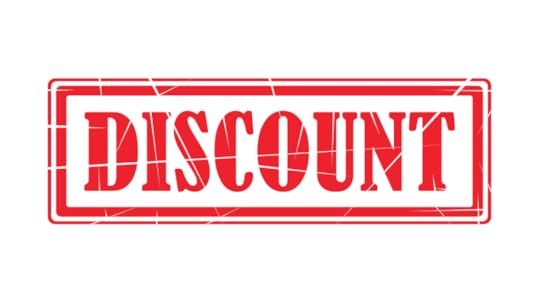
It is easy to blame the salespeople for rampant discounting but
it has always been my experience that the primary responsibility for
over-zealous discounting and the resulting price and margin erosion rests with
management.
When a manager has a surplus, whether of inventory or of
salespeople not hitting their numbers (meaning that he or she isn’t hitting
their number either), they look for a solution in the form of a discount.
Approach the end of the month or quarter with too much inventory on the shelves
or too many people not hitting their quota, and the first thing many managers
do is authorize their salespeople to offer a discount to a customer to win an
order and move some product.
All parties involved in a sales transaction, buyer and seller,
are familiar with this cause and effect scenario. Salespeople wait for it.
Customers wait for it. It is not an accident that the trajectory of orders
during a quarter traces the familiar hockey stick shape. Everyone is familiar
with the rules and is in on the game.
The problem with this end of period discounting is that these
“one-time” discounts have a tendency to morph into the new default
price point for your customer. If you’re handing out discounts at the end of a
quarter to induce customers to close an order or accelerate a delivery, then
your next order from that customer is going to be at the new price point you
established with the discount. Balk at that and you’ll find that all your orders
from customers will start to materialize around the end of your accounting
periods.
Surplus is also a key factor in discounting conducted by
salespeople. It occurs because salespeople oversell their product or service,
in effect offering more features than what the prospect needs to meet their
needs. This overselling occurs when salespeople are not adept at precisely
qualifying their prospect’s exact requirements. A salesperson can’t sell value
if they don’t understand the problem the customer is trying to solve. As a
consequence, they tend to sell the entire feature set of their product or
service in the hope of encompassing the prospect’s needs in the process.
When a salesperson’s offer exceeds the needs of the customer
they are left with the choice of reducing either the scope of their offer or
their price in an attempt to win the order. Offering surplus features that are
without value to the customer almost always leads to a discount.
As a manager, to effectively address this discounting problem
you need to develop a plan to reduce the surplus factors in your selling.
First, the answer for salespeople who oversell is ongoing in-depth product
training. Learning to sell value is next to impossible without a true
understanding of your product or service. A rule of thumb is that a salesperson
can’t effectively sell value if they don’t understand their product better than
the prospect. Does your training accomplish that?
The second surplus factor to manage is the end-of-quarter
discounting syndrome. This is a hard habit for management to break.
Unfortunately going cold-turkey is the only effective method to curtail the
practice. It could take one or two
challenging quarters to flush the temptation out of your system and re-train
your salespeople, prospects and customers. However, you will learn which
customers are buying your product for the value versus the discount. These are
the customers to focus on in the future.
Are you chasing a buck instead of disqualifying a
prospect?
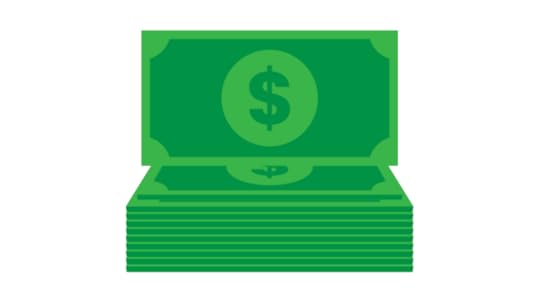
When a potential prospect tells you that your product is ‘too
expensive’ what they usually mean is that your product is just that, too
expensive for their budget. It isn’t an objection. It is a fact. Sometimes a
prospect just can’t afford what you are selling. Even if they are otherwise a
perfect fit for your product or service.
Unfortunately, salespeople are often too busy chasing a buck to
really listen to the customer. They desperately cling to these so-called
prospects, which really aren’t prospects, because they are loathe to kick any
potential buyer to the curb. But, as a consequence, they skip what should be an
essential early step in their sales process: qualifying the prospect on price.
Price Qualification
There is no mystery to price qualification. Qualifying a
prospect on price means that you reach a preliminary agreement about the value
that the prospect will receive from your product in exchange for the dollars
they are going to pay you. In other words, you have reached a tentative
agreement with the prospect that your price is proportional to their assessment
of your product’s value.
Unfortunately, salespeople have an unhealthy fear of the price
question. They want to keep it in a closet somewhere and forget about it. It
scares them. Like zombies or movies based on Jane Austen novels. They are
afraid that any discussion of price will scare off the prospect. Which is
exactly the point.
The downside to the salesperson of not qualifying, or
disqualifying, a prospect on price is the risk of wasting their limited and
valuable selling time on buyers who will not buy.
When
Should You Qualify on Price?
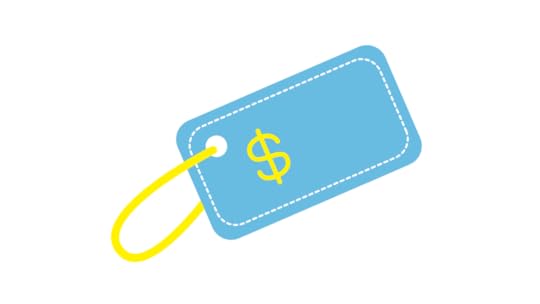
Price qualification’s rightful place is early in the sales
process, during the discovery and qualification phase, because a price
objection is a valid reason for you to disqualify a prospect. First, ask the
right questions of the prospect to fully understand their requirements and make
sure these are aligned with your value proposition (aka your features, benefits
and advantages.) Then clearly lay out the value, price and the ROI they can
expect from your solution based on their stated requirements. If you can’t
reach a preliminary agreement with the prospect on your “value for price” at
this stage, then you probably need to walk away.
Qualification on price and value doesn’t mean that your prospect
is 100% in love with your price. But it does mean they agree that you’re in the
ballpark and any further discussions of price will be a negotiation, not
handling an objection.
This begs then the central question: can you get a price
objection from a truly qualified prospect?
‘Dude,
that’s not a qualified prospect.’
A true price objection surfaced by your prospect at the end
stages of the sales cycle usually means one of two things: A) you misplaced
your backbone at the moment of truth and didn’t disqualify them when you had
the opportunity, or B) you didn’t fully disclose your price during
qualification. If it is A, then they were never a true prospect for your
product or service and you wasted your valuable sales time on someone who was
never going to buy from you. If the answer is B, then you misled the prospect
about your value proposition and it will be difficult to rebuild your
credibility with the prospect and win the order.
Finally, a warning. If you do a good job of qualifying the
prospect on price, but they keep pushing back on price while ostensibly still
moving forward with you in their buying process, then you should proceed with
caution. It is possible the buyer has a hidden agenda and is using you in order
to advance it. I remember one very large deal, early in my career, where the
prospect kept raising price objections even though I had carefully qualified
them. Unfortunately, I was inexperienced and made the mistake of responding to
these objections. I didn’t have the experience to understand that the prospect
was using me as a leverage point to negotiate a better deal with the
competition. It was a painful lesson learned.
Recently I received an email concerning a tele-seminar that was
to be held on the subject of the “dreaded price objection.” For 50 minutes, and
about the same number of dollars, I could learn how to find out “what people
really mean when they say you’re too expensive.” Really? That doesn’t require a
lot of translation.
It has been my experience that when a customer tells me that my
product is too expensive that what they usually mean is that my product is just
too expensive. It isn’t an objection. It is a fact. Sometimes a customer just
can’t afford what you are selling. Which
means that instead of investing your limited selling time in a fruitless
attempt to convince the customer to accept your price that you need develop
some new prospects that don’t have the same budgetary constraints. But let’s
get back to that in minute.
‘I really like your product but your price is too expensive.’
For instance, I recently stopped into a Bentley dealership. I really like the
Bentley Continental Supersports. Who wouldn’t want one? But it’s $260,000 price
tag has about three too many zeros for my checkbook. If the Bentley salesperson
thought that he was going to navigate the shoals of my price objection and
arrive at a signed purchase contract then he would have wasted a significant
amount of his limited time with me. In this case I never got the opportunity to
voice my ‘price objection’ because the salesperson took one look at the car I
drove up in and made himself scarce before I even walked in the door.
I have four simple rules of thumb about price objections and
price qualification that I have successfully taught to clients and salespeople
over the course of many years.
1. Qualifying a prospect on price means that you reach a rough
agreement with the prospect that your price is proportional to their assessment
of your solution’s (product or service) value. In other words, you have reached
a preliminary agreement about the value that the prospect will receive for the
dollars they are going to pay you. Qualification on price and value doesn’t
mean that a prospect is in love with your price. But it does mean you’re in the
ballpark and any further discussions of price will become a negotiation, not
handling an objection.
2. A price objection is a valid reason to disqualify a prospect
and must take place early in the sales process. A true price objection from
your prospect late in the sales cycle means that you misplaced your backbone at
the moment of truth and didn’t disqualify them when you had the opportunity.
They were never a true prospect for your product or service and you just wasted
a lot of time with someone who was never going to buy from you.
3. Be direct with the prospect about your pricing. Salespeople
have developed an unhealthy fear of the price question. They want to put it in
a closet somewhere and forget about it. It scares them. Like zombies or movies
based on Jane Austen novels. There is no mystery to qualifying on price. The
shortest distance between two points is a straight line. Do what you do best.
Ask the right questions of the customer to understand their requirements and
make sure they are aligned with your features and specs. And then talk price and value based on their
requirements.
4. You can’t have a price objection from a truly qualified
prospect. As discussed in #1 above, an intrinsic part of prospect qualification
is a rough agreement on price and value. If the prospect is still pushing back
on price but wants to move forward with you in their buying process then you
should beware. It is possible the buyer has a hidden agenda and is using you in
order to advance it. I remember one very large deal I worked on where the
prospect kept my company in the deal even though they kept whining about our
price. We were confident in our solution so we constructively responded to his
pricing concerns. But then it reached a point where it became obvious that he
was just using us as a leverage point to negotiate a better deal with our
competition. It was a painful lesson learned.
The post Category Qualification vs Product Qualification appeared first on Andy Paul.
November 20, 2019
Stories In Selling – Are Your Stories Worth Repeating?

Take
Advantage of the “Telephone Effect”
A lot has been recently written about the
power of stories in selling. The power of stories to communicate context and
value is undeniable, if they are used correctly.
The effective use of stories requires you to
remember that the exclusive audience for your story is not the person to whom
you initially told the story. Even if that person is the final decision maker.
You have to make your stories memorable and repeatable. Because they need to be
retold throughout the prospect’s company to take advantage of the
“telephone effect.”
What’s the “telephone effect?” When you were a
kid, do you remember playing the game called “telephone?”
The rules were pretty simple. You and your
friends sat on the floor in a big circle. One person started the game by
whispering a short piece of gossip or fiction, usually something slanderous
about one of the kids in the circle, into the ear of the kid sitting to their
left. That kid in turn whispered what they had heard into the ear of the kid
sitting to their left. And on and around the story traveled from ear to ear
until the last kid to have heard the “telephone message” stood up and
repeated what they think they heard. What started out as “Jack and Jill
went up the hill to fetch a pail of water” invariably turned into
“Jill hijacked a pill truck with Gayle, her daughter.”
This same dynamic is in play with the stories and the presentations you tell your prospects. You need to harness the power of the “telephone” dynamic to your sales advantage. Here’s how to do it and it all starts with the stories you tell.

Your stories have to be memorable so your
prospect wants to repeat them internally. Your internal sales advocates have to
be able to communicate your value to multiple audiences throughout the
organization. Those people will in turn re-tell the story to other audiences.
When that happens your value, features, benefits inevitably are amplified
through the retelling. This is the telephone effect kicking in and working to
your advantage. The more memorable your story, the more often it is re-told.
Your stories have to be easily repeatable so
the prospect can effectively re-tell them. You stories have to be concise and
flow in a logical fashion. They have to be entertaining, which means that you
have to practice telling them. They have to be clear about the value you
provide. The key to making your stories repeatable is to make certain they
quickly answer four simple questions in logical order:
1. Why did the customer first call your company?
2. What problem(s) were they trying to solve?
3. Why did they select your company and product/service?
4. What value did the customer receive from your product/service?
Stories that are memorable and repeatable will
accelerate your ability to Sell with Maximum Impact in the Least Time and
compress buying cycles.
The post Stories In Selling – Are Your Stories Worth Repeating? appeared first on Andy Paul.
November 19, 2019
Are You Running A Lead Deficit?
The most important number that every sales rep
needs to know before he or she can build an effective sales plan for the new
sales year is their Lead Deficit. To give yourself a solid chance of making
your quota you have to know this number.
Here’s how it works.
Making quota is based on winning a certain number of orders at a certain Average Order Size (or Average Sales Price.) Some percentage of those orders will come from existing accounts. The rest will come from new business opportunities. Of those new business opportunities, a certain percentage will be derived from sales opportunities generated by inbound sales leads and the rest necessarily will flow from your proactive prospecting efforts. That number of new sales leads that you need to generate through your own proactive prospecting is called your Lead Deficit.
The Lead Deficit forms the heart of your detailed sales action plan. What are the actual steps you will take each and every day to identify and connect with a sufficient number of new customer opportunities to ensure that you will achieve your quota?
What’s
Your Lead Deficit?
Here’s a simple method to calculate your Lead
Deficit and to accurately estimate the type and quantity of the sales
activities that need to be a part of your sales plan. It shouldn’t require more
than 30 minutes of your time to do this. And, I guarantee that if you are able
to close your Lead Deficit, you’ll make quota for the year.
This calculation requires some data and some
assumptions. Let’s start with the data points you need to gather.
1. What is your lead conversion rate?
Historically, what percentage of your sales leads do you convert into orders? You should know this important performance statistic by heart. If you don’t, don’t guess. Go back and calculate it based on your sales records over the past 12 months.
2. What is your Average Order Size?
This is different than your company’s Average Sales Price. You don’t want to use the average achieved by all the salespeople in your company. This is your plan. It has to be based on your track record. Therefore, you need to use your specific Average Order Size (AOS.) Again, don’t guess. Go back and look at your order book for the past 12 months and count the number of orders you closed. Divide your total sales dollars for 2014 by the number of orders you closed to get your AOS.
3. What fraction of your business did you get from existing customers?
Calculate the dollar value of the orders you received from existing customers in 2013 and 2014. Get those precise numbers from your sales records. Add those two years together and divide by 2. Then divide that number again by your Average Order Size. The result is the number of orders from existing customers that you will plug into your model.
4. How many inbound sales leads did you receive in 2014?
Go back into your CRM records and count how many sales leads you received each month for the previous 12 months. Take the lowest monthly number out of the previous 12 months to use in your model. Don’t use an average number. And don’t assume that the number of sales leads you receive is going to increase. Always use the most conservative scenario to incorporate into your model.
Now let’s build a simple model to calculate your Lead Deficit that you can use to start your planning. We’ll use sample data points I created to illustrate how it works. (There are ways to refine this model that would require more space than I have available to explain. If you want more information on how to build this model join me in The Sales House .)
.)
Let’s Look At Some Sample Data…
Lead conversion rate = 20%Average Order Size = $20,000# of orders from existing customers = 10# of inbound leads = 60 per year/5 per month
Step 1: Divide Your Quota by Your Average Order Size
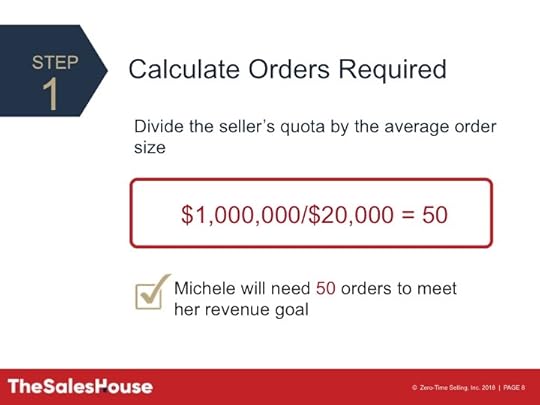
Let’s assume your quota is $1,000,000 per
year. Based on the Average Order Size, you’ll need to win 50 orders in order to
achieve quota.
Step 2: Subtract Orders from Existing Customers

Subtract 10 (orders from existing customers) from 50 (total orders needed) and the result is that you’ll need to win 40 orders from new business opportunities to make your quota.
Step 3: Divide the # of Orders by Your Lead Conversion Rate
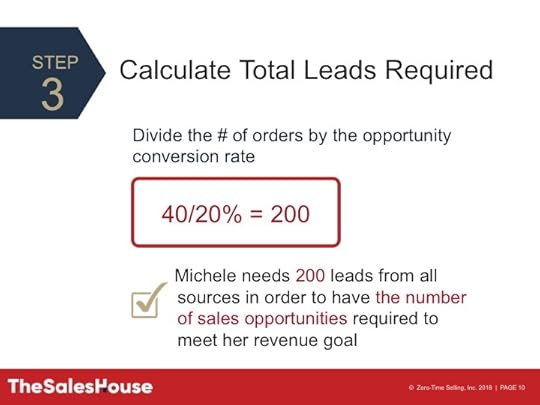
Based on your 20% Lead Conversion Rate you’re
going to need 200 total leads from all sources in order to meet your quota.
Step 4: Subtract Inbound Sales Leads from Total Required Sales Leads
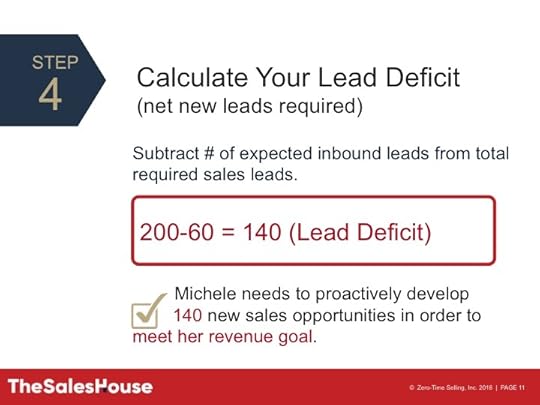
Subtract 60 inbound leads from the 200 total leads required and the difference is the 140 new sales opportunities that you will need to proactively develop on your own.
In other words, your Lead Deficit is equal to 140. Based on your past performance (which is the most accurate guide to future performance,) 140 is the minimum number of sales leads that you must proactively develop in order to meet your quota.
So, before you start creating your sales plan, take a few minutes now and calculate your Lead Deficit. This is absolutely essential to enable you to answer you the primary questions in your sales plan:
What are the specific proactive prospecting activities that have to form the basis of your daily sales routine in order to develop a sufficient number of sales opportunities to eliminate your lead deficit?What are the metrics that you will use to track your progress on a weekly and monthly basis?
As a salesperson your job boils down to doing
whatever hard work is required to meet your goals. This means investing your
time to execute a disciplined prospecting process (e.g., doing some research to
pick targets, making connections online, getting on the phone, or going out and
making calls.) Which is always much easier to do when you can see the target in
plain sight.
The post Are You Running A Lead Deficit? appeared first on Andy Paul.
November 18, 2019
Challenge Your Own Status Quo
“In all affairs, it’s a healthy thing now and then to hang a question mark on the things you have long taken for granted.”
That’s from the famed philosopher, Bertrand Russell.
This applies in spades to sales.
We are stuck on paradigms of how we sell, how we train and develop sellers and how we manage and measure performance that aren’t serving the needs of your sellers (or your buyers.)
Sales training is one prime example.
Multiple data points show declining B2B sales performance across the board and, yet, with few exceptions, we’re still fundamentally training sellers the same way we have for decades.
We need to hang a question mark on that.
The problem is not the content or the trainers. It’s how sales leaders approach the critical task of developing the skills, acumen and overall competence of their sellers.
Let’s start with the fact that too many sales leaders look at training as an obligation to fulfill instead of a recognizing the clear competitive advantage to developing a continuously educated sales force.
Look, there’s nothing wrong with hiring a trainer to come in from time to time and present to your sales team. The paradigm breaks when you start to believe that that is sufficient or adequate.
David Epstein, in his excellent book, Range, cites ample research that show the processes that we use to educate and train workers aren’t effective. That they don’t contribute to the effective acquisition or retention of new information that can be applied in practice.
For me, the biggest problem I have with the prevailing sales training paradigm is that it treats training as an event that is distinct from the job of selling.
The more effective approach is to prioritize sales education and integrate continuous active sales learning into every work day. The technology and the content to support his already exist.
Set aside just 15 minutes a day for active learning. By that I mean, the entire sales team stops whatever they’re doing and engages in active learning. That could be reading a sales book, taking an online course, watching a skills video and discussing it as a group.
I’m always amused at the self-defeating behavior of sales leaders who claim that they can’t spare 15 minutes per day to develop their behavior and skills of their sellers. 15 minutes is just 3% of a standard 8-hour work day.
You can’t invest 3% to make the other 97% more productive?
The post Challenge Your Own Status Quo appeared first on Andy Paul.
How to Transform Your Sales Responsiveness
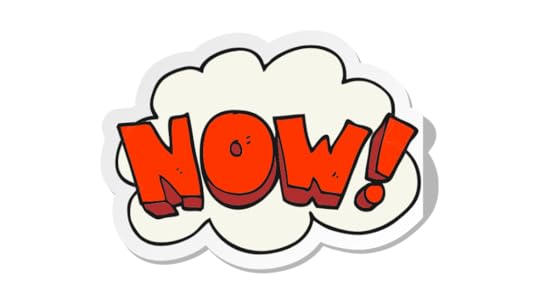
In sales, your
competitors are not your enemy. Time is your enemy. Time is the most limiting
aspect of your sales efforts. You need time to develop new prospects. You need
to get time from your crazy busy prospects to sell to them. And you need time
to help your qualified prospects move through their buying process to a
decision.
Customers today look to
sellers to help them gather the data and information they need make sound
decisions quickly and at a low cost. The successful salesperson anticipates the
information requirements of the customer and uses responsiveness to help the
customer make an informed purchase decision with the least investment of time
possible. The faster and more completely you can be responsive to the customer,
the less able your competitors will be to compete.
The way to stay ahead of
the customer is to adopt the mindset that you will Do Everything Now: become
more responsive and dramatically improve the service you provide your
customers, in order to win more orders in less time.
Don’t wait to get
started. It’s not enough to say you want to Do Everything Now. You have to back
up your talk with action. The way to do that is to set measurable targets
(metrics) for all of your sales processes, and continually manage your
processes to outperform them.
Setting Your Speed Targets

Zero-Time Selling
requires that your interactions with the customer have MILT—Maximum Impact in
the Least Time. Establish speed targets for core sales activities. It may take
you months or more to reach these goals. That is perfectly fine, as long as you
make continuous progress. Here are some good starting speed targets to aim for.
And what if you reach these goals? Keep going! Go even faster!
1. Logging and distributing an in-bound lead:
Within 30 minutes of the
time a lead is received, regardless of its source, it should be logged in your
CRM system and distributed to your salespeople. If they are leads that came in
overnight, they should be logged and distributed within 30 minutes of the start
of the business day.
2. Responding to a lead:
All leads should be
called within 30 minutes of being received by the salesperson.
3. Responding to questions:
Responding to a customer
service call and addressing a customer’s problem should happen in 30 minutes or
less. This doesn’t necessarily mean that the customer’s problem is solved in 30
minutes. It does mean that each customer receives a personal response in 30
minutes, not an automated acknowledgment from a CRM system. All calls must be
answered by a live technical- or customer-support person. If a question cannot
be answered during the first call with a customer, then the follow-up response
with complete information must be made to the customer within one hour of the
end of the call.
4. Delivering a quote:
All quotes should be
delivered to the prospect/customer on the same day that they were requested.
Use a proposal preparation app or re-use templates of previous quotes and
proposals to prepare quotes rapidly.
5. Customer Documentation.
All required CRM documentation
of customer interactions must be entered before the end of the business day.
All account activity is entered, including emails, documentation of phone calls
and sales calls, customer-support activity, quotes, and proposals. Having
immediate access to the latest up-to-date information can accelerate your
accounting planning.
6. Clearing customer messages.
There are multiple
avenues for hearing from your customers. Irrespective of the source, all
messages from customers must be cleared by the end of each business day.
Emails, voicemails, phone messages, and text messages must all be cleared the
same day they are received. It’s not often that a customer sends an email just
to say “Hi.” You have to assume that any customer who contacts you wants information.
Provide the information they need right now. Don’t let it sit for a day or
more. Don’t inject unnecessary delay into the customer’s buying cycle.
Hitting Your Speed Targets

Once you’ve established
speed targets, how can you make sure you hit them? Here are six proven
recommendations:
1. Clearly communicate speed expectations to your team.
Make certain that all
sales and service team member understand your expectations with regard to
responsiveness (content + speed) and MILT in all of their interactions with
prospects and customers. This has to be done upfront. The commitment to
responsiveness and MILT, what I call Zero-Time Selling, starts at the top.
2. Frequently check individual progress against assigned target metrics.
Implementing routine
checks of key metrics in daily huddles or sales meetings will quickly reveal
whether your “Do Everything Now” processes are on target, and if they’re not,
will highlight the reasons they’re behind schedule.
Remember that this is an
iterative process. Choose the processes you want to accelerate, establish your
speed targets, measure the results, tweak the process, measure the results
again, and keep adjusting the process and measuring the results until you
achieve your targets. Then, define a new, more aggressive target, and continue
with the process. You continually want to improve your processes as your sales
results improve. It’s work, but in the end you’ll find that it’s very
profitable.
3. Manage your sales opportunities by focusing on responsiveness and MILT.
There are several things
you can do in this regard. Review every sales opportunity with the goal of
maximizing responsiveness and MILT. When you review a salesperson’s pipeline of
sales opportunities, he or she should know the specific actions they are going
to take to provide maximum value to the customer on the next sales interaction.
In addition, review the CRM records of prospects to review the actions that
have already been taken with a sales prospect to spot any requirements or opportunities
that may have been missed. Discuss what the salesperson could have done to be
more responsive and use those as teaching examples.
4. Monitor assigned follow-ups in your CRM system.
As a manager, you need
to stay on top of the quantity and timing of each salesperson’s follow-ups and
assigned tasks. If a quick check shows that Danni has a backlog of 50
follow-ups that are overdue, then clearly she is struggling with her
responsiveness. Customers want information, and she isn’t getting them the
answers they need, which compromises your competitive position.
5. Coach salespeople to eliminate trivial and time-wasting sales calls.
The amount of time you insert unnecessarily between steps in the sales process with a prospect is destructive to your selling efforts. That time is called an “Indecent Interval”: injecting unnecessary delay into the customer’s buying cycle. Doing this opens the door for the competition to take the business away.

The “Wallet Pretext” is
a venerable technique a salesperson uses to create an artificial reason to
contact the customer once more. Anyone who has ever dated has used the “Wallet
Pretext.” You really enjoyed your blind date and hated to call it a night. You
couldn’t wait to see her again, but you wanted to make sure to wait an
appropriate amount of time before calling her, so you didn’t appear too
anxious. So you used the “Wallet Pretext”: “Hey, I am sorry for bothering you,
but I can’t find my wallet today. I think I might have dropped it at your
apartment last night. Would you mind if I stopped by to look for it?”
In sales, the “Wallet
Pretext” is used all the time by salespeople who don’t understand that part of
their job is to create value for their customers. Too many salespeople are in
the habit of calling customers “just to touch base.” Customers hate these time
wasters. If you aren’t responding to a specific request, think carefully before
contacting a prospect. Will the call create value for the customer? If not,
don’t pick up the phone.
The “Wallet Pretext” and
the “Indecent Interval” are often found together in the bag of techniques
salespeople incorporate into their daily routine. They are bad habits that need
to be stamped out. The “Indecent Interval” especially is pervasive in selling.
Even in this era of email, voicemail, smartphones, chat, and social media, the
indecent interval exists. It is a creation of salespeople. It is not the
customer who continues to use it, but the salesperson who lacks confidence in
the value he or she is providing to the customer.
6. Continually review and analyze how your sales process performance stacks up against your target metrics.
Review progress toward
achieving your target metrics. Someone within your organization should be
assigned to calculate performance against the target. An administrative staff
member can develop a spreadsheet or other reporting structure to track
performance. Graph these for reporting purposes in meetings. Analyze metrics
weekly. Reporting on your sales process statistics should be a part of every
weekly sales meeting. Performance against these metrics should also be reviewed
by executive staff.
Remember: prospects
these days are estimated to have moved 50%-75% through their buying process
before they first contact you. At that point, they have fewer questions that
need to be answered before they can make a decision and their timing is urgent
(given that they started their buying process well before you first engaged
with them.) Make certain that your salespeople and sales processes are prepared
to Do Everything Now and you will have the inside track on winning that
business.
The post How to Transform Your Sales Responsiveness appeared first on Andy Paul.
12 Steps to Transform Your Sales Responsiveness
Now” when Selling

In sales, your
competitors are not your enemy. Time is your enemy. Time is the most limiting
aspect of your sales efforts. You need time to develop new prospects. You need
to get time from your crazy busy prospects to sell to them. And you need time
to help your qualified prospects move through their buying process to a
decision.
Customers today look to
sellers to help them gather the data and information they need make sound
decisions quickly and at a low cost. The successful salesperson anticipates the
information requirements of the customer and uses responsiveness to help the
customer make an informed purchase decision with the least investment of time
possible. The faster and more completely you can be responsive to the customer,
the less able your competitors will be to compete.
The way to stay ahead of
the customer is to adopt the mindset that you will Do Everything Now: become
more responsive and dramatically improve the service you provide your
customers, in order to win more orders in less time.
Don’t wait to get
started. It’s not enough to say you want to Do Everything Now. You have to back
up your talk with action. The way to do that is to set measurable targets
(metrics) for all of your sales processes, and continually manage your
processes to outperform them.
Setting Speed Targets

Zero-Time Selling
requires that your interactions with the customer have MILT—Maximum Impact in
the Least Time. Establish speed targets for core sales activities. It may take
you months or more to reach these goals. That is perfectly fine, as long as you
make continuous progress. Here are some good starting speed targets to aim for.
And what if you reach these goals? Keep going! Go even faster!
1. Logging and distributing an in-bound lead:
Within 30 minutes of the
time a lead is received, regardless of its source, it should be logged in your
CRM system and distributed to your salespeople. If they are leads that came in
overnight, they should be logged and distributed within 30 minutes of the start
of the business day.
2. Responding to a lead:
All leads should be
called within 30 minutes of being received by the salesperson.
3. Responding to questions:
Responding to a customer
service call and addressing a customer’s problem should happen in 30 minutes or
less. This doesn’t necessarily mean that the customer’s problem is solved in 30
minutes. It does mean that each customer receives a personal response in 30
minutes, not an automated acknowledgment from a CRM system. All calls must be
answered by a live technical- or customer-support person. If a question cannot
be answered during the first call with a customer, then the follow-up response
with complete information must be made to the customer within one hour of the
end of the call.
4. Delivering a quote:
All quotes should be
delivered to the prospect/customer on the same day that they were requested.
Use a proposal preparation app or re-use templates of previous quotes and
proposals to prepare quotes rapidly.
5. Customer Documentation.
All required CRM documentation
of customer interactions must be entered before the end of the business day.
All account activity is entered, including emails, documentation of phone calls
and sales calls, customer-support activity, quotes, and proposals. Having
immediate access to the latest up-to-date information can accelerate your
accounting planning.
6. Clearing customer messages.
There are multiple
avenues for hearing from your customers. Irrespective of the source, all
messages from customers must be cleared by the end of each business day.
Emails, voicemails, phone messages, and text messages must all be cleared the
same day they are received. It’s not often that a customer sends an email just
to say “Hi.” You have to assume that any customer who contacts you wants information.
Provide the information they need right now. Don’t let it sit for a day or
more. Don’t inject unnecessary delay into the customer’s buying cycle.
Hitting Speed Targets

Once you’ve established
speed targets, how can you make sure you hit them? Here are six proven
recommendations:
1. Clearly communicate speed expectations to your team.
Make certain that all
sales and service team member understand your expectations with regard to
responsiveness (content + speed) and MILT in all of their interactions with
prospects and customers. This has to be done upfront. The commitment to
responsiveness and MILT, what I call Zero-Time Selling, starts at the top.
2. Frequently check individual progress against assigned
target metrics.
Implementing routine
checks of key metrics in daily huddles or sales meetings will quickly reveal
whether your “Do Everything Now” processes are on target, and if they’re not,
will highlight the reasons they’re behind schedule.
Remember that this is an
iterative process. Choose the processes you want to accelerate, establish your
speed targets, measure the results, tweak the process, measure the results
again, and keep adjusting the process and measuring the results until you
achieve your targets. Then, define a new, more aggressive target, and continue
with the process. You continually want to improve your processes as your sales
results improve. It’s work, but in the end you’ll find that it’s very
profitable.
3. Manage your sales opportunities by focusing on responsiveness
and MILT.
There are several things
you can do in this regard. Review every sales opportunity with the goal of
maximizing responsiveness and MILT. When you review a salesperson’s pipeline of
sales opportunities, he or she should know the specific actions they are going
to take to provide maximum value to the customer on the next sales interaction.
In addition, review the CRM records of prospects to review the actions that
have already been taken with a sales prospect to spot any requirements or opportunities
that may have been missed. Discuss what the salesperson could have done to be
more responsive and use those as teaching examples.
4. Monitor assigned follow-ups in your CRM system.
As a manager, you need
to stay on top of the quantity and timing of each salesperson’s follow-ups and
assigned tasks. If a quick check shows that Danni has a backlog of 50
follow-ups that are overdue, then clearly she is struggling with her
responsiveness. Customers want information, and she isn’t getting them the
answers they need, which compromises your competitive position.
5. Coach salespeople to eliminate trivial and
time-wasting sales calls.
The amount of time you insert unnecessarily between steps in the sales process with a prospect is destructive to your selling efforts. That time is called an “Indecent Interval”: injecting unnecessary delay into the customer’s buying cycle. Doing this opens the door for the competition to take the business away.

The “Wallet Pretext” is
a venerable technique a salesperson uses to create an artificial reason to
contact the customer once more. Anyone who has ever dated has used the “Wallet
Pretext.” You really enjoyed your blind date and hated to call it a night. You
couldn’t wait to see her again, but you wanted to make sure to wait an
appropriate amount of time before calling her, so you didn’t appear too
anxious. So you used the “Wallet Pretext”: “Hey, I am sorry for bothering you,
but I can’t find my wallet today. I think I might have dropped it at your
apartment last night. Would you mind if I stopped by to look for it?”
In sales, the “Wallet
Pretext” is used all the time by salespeople who don’t understand that part of
their job is to create value for their customers. Too many salespeople are in
the habit of calling customers “just to touch base.” Customers hate these time
wasters. If you aren’t responding to a specific request, think carefully before
contacting a prospect. Will the call create value for the customer? If not,
don’t pick up the phone.
The “Wallet Pretext” and
the “Indecent Interval” are often found together in the bag of techniques
salespeople incorporate into their daily routine. They are bad habits that need
to be stamped out. The “Indecent Interval” especially is pervasive in selling.
Even in this era of email, voicemail, smartphones, chat, and social media, the
indecent interval exists. It is a creation of salespeople. It is not the
customer who continues to use it, but the salesperson who lacks confidence in
the value he or she is providing to the customer.
6. Continually review and analyze how your sales process
performance stacks up against your target metrics.
Review progress toward
achieving your target metrics. Someone within your organization should be
assigned to calculate performance against the target. An administrative staff
member can develop a spreadsheet or other reporting structure to track
performance. Graph these for reporting purposes in meetings. Analyze metrics
weekly. Reporting on your sales process statistics should be a part of every
weekly sales meeting. Performance against these metrics should also be reviewed
by executive staff.
Remember: prospects
these days are estimated to have moved 50%-75% through their buying process
before they first contact you. At that point, they have fewer questions that
need to be answered before they can make a decision and their timing is urgent
(given that they started their buying process well before you first engaged
with them.) Make certain that your salespeople and sales processes are prepared
to Do Everything Now and you will have the inside track on winning that
business.
The post 12 Steps to Transform Your Sales Responsiveness appeared first on Andy Paul.
November 15, 2019
The Definitive Guide To Improving Your Sales Hiring

 How would you respond to the question: What’s your sales type?
How would you respond to the question: What’s your sales type?
 Why you should never “swing at the first pitch.”
Why you should never “swing at the first pitch.”
 The 5 Steps to Find and Hire The Best Sales Candidates
The 5 Steps to Find and Hire The Best Sales Candidates
 BONUS: 2 Tips to Conduct Effective Reference Checks.
BONUS: 2 Tips to Conduct Effective Reference Checks.
How would you respond to the question: What’s your sales type?
I recently read that the
cost of a bad sales hire is 7 times (7x) the annual salary of that position.
You would think that such a stiff penalty would provide sufficient incentive
for hiring managers to do a much better job of specifying their requirements for
an open sales slot, as well as identifying and hiring the right candidates. And
yet, sales managers and CEOs repeat the same sales hiring mistakes time and
time again.
The problem usually
resides with the hiring manager, whether that is a CEO, owner, or sales
manager. While the job description for a sales opening might say all the right
things about the skills, experience, and personal qualities the candidate needs
to have, the CEO and sales manager usually have the list boiled down to a few
stereotypical qualities:
HunterCloserOutgoingAggressive
In the January/February
2013 issue of the Harvard Business Review,
Jeff Bezos, founder and CEO of Amazon.com, was quoted as follows: “We
don’t make money when we sell things; we make money when we help people make
purchase decisions.”
To me, that statement
simply and accurately says what selling is. And from that description I can
identify 4 personal characteristics of a salesperson that help their prospects
make good purchase decisions:
CuriosityEmpathyProblem-solving skillsResponsiveness
Now let’s review that list of characteristics that hiring managers typically have in mind while they are looking to hire a salesperson: Hunter, Closer, Outgoing, Aggressive. Which of those qualities helps customers make purchase decisions? Any of them? Of course not.
Never Swing At The First Pitch

Using a Little Patience at the Plate Will Improve Your Sales Hiring
Think back to your days
in Little League baseball or softball. You probably got this nugget of advice
from the baseball dads who coached your team: Never swing at the first pitch.
The idea was that you could learn something about the tendencies and capabilities
of the pitcher if you just watched the first pitch cross the plate.
On radio and TV baseball
broadcasts the color commentary guy sometimes talks about the batter in a
slightly condescending manner, describing him as “a first-pitch hitter.” The
implication is that the batter should be patient and “work the count” until he sees a pitch that
he likes. We could argue ad nauseam about whether not swinging on a 0-0 count
is a good strategy or just recycled baseball folklore. But for better or worse,
it has become a de facto standard of play for batters in baseball.
I recommend that “never
swing at the first pitch” should be the standard you apply to hiring
salespeople as well. In my experience, hiring managers typically are not very
effective evaluators of sales talent and often take the path of least
resistance with sales candidates, using one of the following three standards
for hiring:
1. The “Love at First Sight” Standard
The hiring manager finds the process of hiring a salesperson so unpleasant that he or she hires the first warm body that walks through the door.
2. The “Armani Suit” Standard
The hiring manager has a formulaic Mom-and-apple-pie list of the skills his company is looking for in a salesperson. Instead of hiring someone with work experience directly tied to his business, he hires generalists, slick sales professionals who dress well and present themselves with a breezy air of self-confidence. They make him feel good about himself, but he is later left to wonder why they don’t work out when they seem so “qualified” on paper, and in person.
3. The “Not Good Enough for my Daughter” Standard
This hiring manager never finds a candidate that meets his or her expectations and harbors a range of emotions, from slight ambivalence to outright hostility to the idea of hiring a salesperson. He knows that salespeople are a necessary evil, but is risk averse and afraid to make a mistake by hiring someone who doesn’t produce.
The goal of your hiring efforts should be to identify and qualify (that’s right, just like selling) the best candidate for the job you need done and to integrate him or her smoothly into your sales team.
5 Steps to Find and Hire The Best Candidates for Sales

Here are 5 tips to help
you do a better job of identifying and qualifying the best candidate for your
sales team.
1. Write an accurate, honest job description
The temptation is to
write too broad a job description, alluding to unspecified opportunities and
responsibilities, hoping to entice a higher level of talent to the company. The
reality is that you do not want to hire only
potential. You want to hire someone with product expertise, industry knowledge,
and successful sales experience.
2. Do in-depth evaluations of multiple qualified candidates
Wait for the pitch
across the fat part of the plate. In hiring a salesperson, this means that you
need to evaluate more than one qualified person for every job opening. It means
that no matter how much you like the first person you interview, you must do
in-depth interviews and reference checks of at least two other candidates
before you decide who to hire.
3. Have your entire management team interview candidates
If you’re reluctant to
have the rest of your peers meet your favorite candidate, then you have a
problem. (Just like the time you hesitated to take your tattooed girlfriend or
boyfriend with the nose ring home to meet Mom.) Selling is a team sport. Hiring
should be a team sport as well. The final decision will rest with the CEO or VP
of Sales, but the company should take advantage of the “wisdom of crowds” by
having people from multiple departments interview all of the qualified
candidates. Make sure that sales candidates are interviewed by all of your
senior management team. Sales touches every part of your organization, and
everyone who works with sales should have input into the hiring of a
salesperson.
4. Test all skills and verify all résumé information
Hiring the wrong
salesperson can be very expensive. If you test and verify skills and
experience, you’ll reduce the probability of making an error in the hiring
process. You’ll avoid the cost of interviewing yet another set of candidates,
as well as the cost of lost orders from new customers. Testing candidates’
technical/product knowledge and sales skills is absolutely essential.
5. Recruit internally
The best place to recruit new salespeople is inside your own company. If your company is in a technical field, then recruit technically capable salespeople from within your engineering and product development departments. Look for the engineers who have exhibited a special knack for customer support or the engineer that every salesperson wants to use as a technical resource on a sales call. This person is already spending a chunk of his or her time selling and is someone you should consider for sales.
BONUS: Two Tips to Conduct Effective Reference Checks.

When do you check the references
for a sales candidate you want to hire? Do you wait until you have made up your
mind to hire someone? That’s what most sales hiring managers do. And it is the
wrong thing to do. References should be checked before you’ve narrowed your
choice down to one candidate.
Think about the typical
sales hiring process. You post an open position and do a preliminary screening
of candidates’ résumés. You develop a small pool of candidates and conduct
preliminary phone or video interviews. You then invite the best candidates for
in-person interviews. From those, you decide that two or three are worthy of
deeper consideration and bring them back for a series of interviews with others
in the company. At that point one candidate stands out from the rest, and you decide
to hire him or her if their references check out.
Here’s the problem with
that scenario: If you’re like most hiring managers, you check your favorite
candidate’s references only after
you’ve decided to hire him or her. Isn’t that backwards? References should
be a source of important data that are factored into the hiring decision. They
are not meant to be a validation of a decision you have already made.
Here are two concrete
steps to take to improve your reference checks:
1. Conduct Reference Checks on Your Final Three Candidates
Take the time to
thoroughly check the references (and qualifications) of each finalist before
investing time and manpower company-wide interviews. Do this before you fall in
love with one candidate and become blinded to their potential shortcomings. Use
fact-based questioning to dig into and verify the claims on each candidate’s
résumé.
2. Sideline the Subjectivity: Ask More Fact-based Questions of References
How can you get the most
out of reference calls? Simple. Don’t rely on questions that require opinions
for answers. References are increasingly reluctant to provide any meaningful,
subjective information by phone or in writing. Therefore you should ask questions
that have factual answers. For example, your candidate states on his résumé
that he achieved 120% of quota last year. Ask the reference to verify that
fact. Or a candidate claims that she made President’s Club for 3 years in a
row. Ask if that is correct. Use references to verify what the candidate tells
you. If you find that a candidate has lied or fudged the truth, you should
disqualify him or her.
I recently met with a VP
of Sales for a growing start-up. We talked about his hiring process. I asked
him how many people in his large and growing sales force he had hired who had
not achieved at least 100% of quota at their prior sales job? He confidently
said none. I asked if he had fact-checked the sales achievement claims on their
résumés. There was a pause. A long pause. Here was a fairly sophisticated sales
management executive who was still taking sales candidates’ performance claims
at face value.
Hiring is a risky
business in the best of circumstances. But sales is one of the few professions
where past performance can be an objective and transparent measure of a
candidate’s ability and future capabilities. Take advantage of this built-in
advantage and stop hiring backwards.
The post The Definitive Guide To Improving Your Sales Hiring appeared first on Andy Paul.
5 Steps To Dramatically Improve Your Sales Hiring

How would you respond to
the question: What’s your sales type?
I recently read that the
cost of a bad sales hire is 7 times (7x) the annual salary of that position.
You would think that such a stiff penalty would provide sufficient incentive
for hiring managers to do a much better job of specifying their requirements for
an open sales slot, as well as identifying and hiring the right candidates. And
yet, sales managers and CEOs repeat the same sales hiring mistakes time and
time again.
The problem usually
resides with the hiring manager, whether that is a CEO, owner, or sales
manager. While the job description for a sales opening might say all the right
things about the skills, experience, and personal qualities the candidate needs
to have, the CEO and sales manager usually have the list boiled down to a few
stereotypical qualities:
1. Hunter
2. Closer
3. Outgoing
4. Aggressive
In the January/February
2013 issue of the Harvard Business Review,
Jeff Bezos, founder and CEO of Amazon.com, was quoted as follows: “We
don’t make money when we sell things; we make money when we help people make
purchase decisions.”
To me, that statement
simply and accurately says what selling is. And from that description I can
identify 4 personal characteristics of a salesperson that help their prospects
make good purchase decisions:
1. Curiosity
2. Empathy
3. Problem-solving
skills
4. Responsiveness
Now let’s review that list of characteristics that hiring managers typically have in mind while they are looking to hire a salesperson: Hunter, Closer, Outgoing, Aggressive. Which of those qualities helps customers make purchase decisions? Any of them? Of course not.
Never Swing at the First Pitch

Using a Little Patience
at the Plate Will Improve Your Sales Hiring
Think back to your days
in Little League baseball or softball. You probably got this nugget of advice
from the baseball dads who coached your team: Never swing at the first pitch.
The idea was that you could learn something about the tendencies and capabilities
of the pitcher if you just watched the first pitch cross the plate.
On radio and TV baseball
broadcasts the color commentary guy sometimes talks about the batter in a
slightly condescending manner, describing him as “a first-pitch hitter.” The
implication is that the batter should be patient and “work the count” until he sees a pitch that
he likes. We could argue ad nauseam about whether not swinging on a 0-0 count
is a good strategy or just recycled baseball folklore. But for better or worse,
it has become a de facto standard of play for batters in baseball.
I recommend that “never
swing at the first pitch” should be the standard you apply to hiring
salespeople as well. In my experience, hiring managers typically are not very
effective evaluators of sales talent and often take the path of least
resistance with sales candidates, using one of the following three standards
for hiring:
1: The “Love at First Sight” Standard: The hiring manager finds the process of hiring a
salesperson so unpleasant that he or she hires the first warm body that walks
through the door.
2: The “Armani Suit” Standard: The hiring manager has a formulaic Mom-and-apple-pie
list of the skills his company is looking for in a salesperson. Instead of
hiring someone with work experience directly tied to his business, he hires
generalists, slick sales professionals who dress well and present themselves
with a breezy air of self-confidence. They make him feel good about himself,
but he is later left to wonder why they don’t work out when they seem so
“qualified” on paper, and in person.
3: The “Not Good Enough for my Daughter” Standard: This hiring manager never finds a candidate that
meets his or her expectations and harbors a range of emotions, from slight
ambivalence to outright hostility to the idea of hiring a salesperson. He knows
that salespeople are a necessary evil, but is risk averse and afraid to make a
mistake by hiring someone who doesn’t produce.
The goal of your hiring efforts should be to identify and qualify (that’s right, just like selling) the best candidate for the job you need done and to integrate him or her smoothly into your sales team.
5 Steps to Find and Hire The Best Candidates for Sales

Here are 5 tips to help
you do a better job of identifying and qualifying the best candidate for your
sales team.
1. Write an accurate, honest job description.
The temptation is to
write too broad a job description, alluding to unspecified opportunities and
responsibilities, hoping to entice a higher level of talent to the company. The
reality is that you do not want to hire only
potential. You want to hire someone with product expertise, industry knowledge,
and successful sales experience.
2. Do in-depth evaluations of multiple qualified
candidates.
Wait for the pitch
across the fat part of the plate. In hiring a salesperson, this means that you
need to evaluate more than one qualified person for every job opening. It means
that no matter how much you like the first person you interview, you must do
in-depth interviews and reference checks of at least two other candidates
before you decide who to hire.
3. Have your entire management team interview candidates.
If you’re reluctant to
have the rest of your peers meet your favorite candidate, then you have a
problem. (Just like the time you hesitated to take your tattooed girlfriend or
boyfriend with the nose ring home to meet Mom.) Selling is a team sport. Hiring
should be a team sport as well. The final decision will rest with the CEO or VP
of Sales, but the company should take advantage of the “wisdom of crowds” by
having people from multiple departments interview all of the qualified
candidates. Make sure that sales candidates are interviewed by all of your
senior management team. Sales touches every part of your organization, and
everyone who works with sales should have input into the hiring of a
salesperson.
4. Test all skills and verify all résumé information.
Hiring the wrong
salesperson can be very expensive. If you test and verify skills and
experience, you’ll reduce the probability of making an error in the hiring
process. You’ll avoid the cost of interviewing yet another set of candidates,
as well as the cost of lost orders from new customers. Testing candidates’
technical/product knowledge and sales skills is absolutely essential.
5. Recruit internally
The best place to recruit new salespeople is inside your own company. If your company is in a technical field, then recruit technically capable salespeople from within your engineering and product development departments. Look for the engineers who have exhibited a special knack for customer support or the engineer that every salesperson wants to use as a technical resource on a sales call. This person is already spending a chunk of his or her time selling and is someone you should consider for sales.
Are You Hiring Backwards? Two Tips to Conduct Effective Reference Checks.

When do you check the references
for a sales candidate you want to hire? Do you wait until you have made up your
mind to hire someone? That’s what most sales hiring managers do. And it is the
wrong thing to do. References should be checked before you’ve narrowed your
choice down to one candidate.
Think about the typical
sales hiring process. You post an open position and do a preliminary screening
of candidates’ résumés. You develop a small pool of candidates and conduct
preliminary phone or video interviews. You then invite the best candidates for
in-person interviews. From those, you decide that two or three are worthy of
deeper consideration and bring them back for a series of interviews with others
in the company. At that point one candidate stands out from the rest, and you decide
to hire him or her if their references check out.
Here’s the problem with
that scenario: If you’re like most hiring managers, you check your favorite
candidate’s references only after
you’ve decided to hire him or her. Isn’t that backwards? References should
be a source of important data that are factored into the hiring decision. They
are not meant to be a validation of a decision you have already made.
Here are two concrete
steps to take to improve your reference checks:
1. Conduct Reference Checks on Your Final Three
Candidates
Take the time to
thoroughly check the references (and qualifications) of each finalist before
investing time and manpower company-wide interviews. Do this before you fall in
love with one candidate and become blinded to their potential shortcomings. Use
fact-based questioning to dig into and verify the claims on each candidate’s
résumé.
2. Sideline the Subjectivity: Ask More Fact-based
Questions of References
How can you get the most
out of reference calls? Simple. Don’t rely on questions that require opinions
for answers. References are increasingly reluctant to provide any meaningful,
subjective information by phone or in writing. Therefore you should ask questions
that have factual answers. For example, your candidate states on his résumé
that he achieved 120% of quota last year. Ask the reference to verify that
fact. Or a candidate claims that she made President’s Club for 3 years in a
row. Ask if that is correct. Use references to verify what the candidate tells
you. If you find that a candidate has lied or fudged the truth, you should
disqualify him or her.
I recently met with a VP
of Sales for a growing start-up. We talked about his hiring process. I asked
him how many people in his large and growing sales force he had hired who had
not achieved at least 100% of quota at their prior sales job? He confidently
said none. I asked if he had fact-checked the sales achievement claims on their
résumés. There was a pause. A long pause. Here was a fairly sophisticated sales
management executive who was still taking sales candidates’ performance claims
at face value.
Hiring is a risky
business in the best of circumstances. But sales is one of the few professions
where past performance can be an objective and transparent measure of a
candidate’s ability and future capabilities. Take advantage of this built-in
advantage and stop hiring backwards.
The post 5 Steps To Dramatically Improve Your Sales Hiring appeared first on Andy Paul.
Andy Paul's Blog
- Andy Paul's profile
- 4 followers



